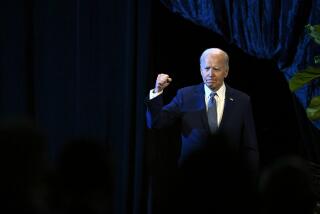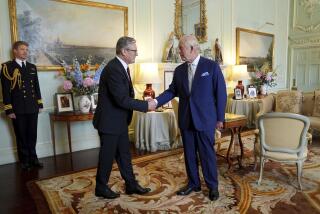And then there were four: a primer on the race in Britain to succeed Theresa May
Reporting from London — The race for British prime minister is on.
Faced with ministerial resignations, rumors of Cabinet revolt and multiple parliamentary defeats of her Brexit deal with the European Union, Theresa May had little choice this month but to formally hand in her resignation.
It sparked a fierce battle to succeed her as Conservative Party leader — and therefore prime minister.
May has said she will remain as acting prime minister until her successor has been chosen. Then she will hand over the keys to 10 Downing Street and go back to being a member of Parliament for her Maidenhead constituency, about 30 miles west of central London.
Here is a look at how that is likely to happen.
Who are the candidates?
When the race started, 10 candidates put their names forward as possible successors. That number has been whittled down by two rounds of secret voting by Conservative lawmakers.
In the first round, on June 13, any candidate with fewer than 17 votes was eliminated, narrowing the field by three. Health Secretary Matt Hancock also pulled out of the race after a weak showing.
During the second round of voting Tuesday, former Brexit Secretary Dominic Raab was eliminated after failing to secure the required 33 votes.
Then on Wednesday, International Development Secretary Rory Stewart was eliminated when he received only 27 votes.
That leaves four candidates: former Foreign Secretary Boris Johnson, Home Secretary Sajid Javid, Foreign Secretary Jeremy Hunt and Environment Secretary Michael Gove.
Johnson, who was one of the leading voices in the campaign to leave the European Union, has emerged as the clear front-runner. He secured the votes of 114 out of a possible 313 Conservative lawmakers in round one and 126 votes in round two.
In round three on Wednesday, he got 143 votes compared with 54 for Hunt, 51 for Gove and 38 for Javid.
It is no secret that the flamboyant and gaffe-prone Johnson has long been waiting for the right moment to make his bid for the top office. Supporters believe he is the only Conservative lawmaker who can not only deliver Brexit and unite the country but also take on Nigel Farage, the leader of the newly formed Brexit Party, which made significant gains in last month’s European elections and campaigns on a staunchly anti-EU platform.
But Johnson’s critics say that he is self-serving and not to be trusted. He has not given any in-depth interview to journalists and skipped the first of two televised debates. He has said little about how he plans to lead if elected.
Instead, he is working behind closed doors to shore up support from lawmakers, who, much like voters, appear intractably divided over when Britain should even leave the European Union.
What are the candidates promising to do?
Gove has said he would be willing to delay the date of Britain’s departure from the EU again if a better deal appeared within grasp.
Hunt, Javid and Johnson have all said they would seek to change the withdrawal agreement but would be willing to see Britain leave without any deal on the current departure date of Oct. 31, a move that economists have warned could be disastrous.
Johnson has taken the most hard-line stance, saying that Britain has to leave the EU on Oct. 31 with or without a deal. He has also threatened to withhold the $49 billion that Britain is due to pay the EU, a move that could end up in court.
Why can’t lawmakers agree on Brexit?
The candidates have all said their top priority is to deliver on Brexit, but that is no simple pledge.
They have repeatedly said that the withdrawal agreement May hashed out with her 27 EU counterparts cannot be reopened and this is the best — and only — deal on offer. But British Parliament has resoundingly rejected the deal three times .
The main sticking point is how to avoid creating a hard border between Northern Ireland, which will leave the EU along with the rest of the United Kingdom, and the Republic of Ireland, which will remain in the EU.
The current withdrawal agreement includes a so-called backstop plan in which the U.K. would essentially remain in the EU’s customs union and Northern Ireland would retain even closer links to the EU by agreeing to some rules of the single market. It would go into effect only if no new trade deal is reached between Britain and the EU by the end of 2020.
But many lawmakers are unwilling to endorse it, including those in the Democratic Unionist Party, on which the Conservative Party relies to maintain a majority in Parliament.
Lawmakers may know what they don’t want, but there is no consensus on what the path ahead should be.
Some are campaigning for a second referendum in the hope that Brexit might be overturned. Others support Brexit in principle but believe it would be an economic disaster for the country to leave without any deal in place. Still others believe Brexit should go ahead with or without a deal.
Proponents of leaving without a deal argue that despite the consequences, Brexit needs to be delivered for the country to move forward. They also believe that only by preparing for a no-deal scenario can they truly play hardball with the EU and secure the kind of deal that British lawmakers will support.
What happens next?
Conservative lawmakers will be asked to cast votes in secret on the remaining four candidates again on Thursday until only two candidates are left.
In each round of voting, the contender who places last and anyone securing less than 33 votes will be eliminated. But it’s not over there. Once only two candidates remain, ordinary members of the Conservative Party will be asked to vote for their preferred candidate.
They number around 160,000 and are members of the public who have paid to be members of the party. More than half of them are 55 or older, and the majority come from the upper social classes.
Once all the votes are in, the new Conservative Party leader — and new prime minister — will be announced in the week commencing July 22.
Boyle is a special correspondent.
More to Read
Sign up for Essential California
The most important California stories and recommendations in your inbox every morning.
You may occasionally receive promotional content from the Los Angeles Times.










